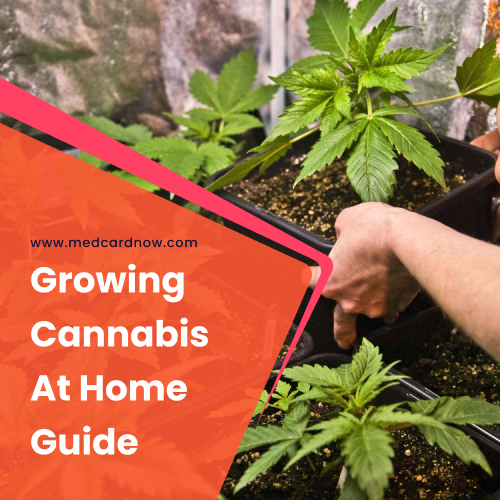
With the legalization of cannabis in many states, growing your own cannabis at home has never been easier. The benefits of an indoor grow operation are clear. You can control the environment and create the perfect conditions for your plants to thrive. In this blog post, we’ll provide an overview of growing cannabis at home. Then we focus on two key components—grow lights and setting up a thriving indoor grow operation.
Growing cannabis at home is an increasingly popular activity among hobbyists, medical patients, and even entrepreneurs. If you’re new to growing cannabis, understanding which type of grow light is best suited for your needs can be tricky. Let’s explore the different types of grow lights available and how to choose the right one for your home garden.
Grow Lights
When it comes to growing cannabis at home, one of the most important components is selecting the right type of light. There are three main types of lights used for growing cannabis: LED (Light Emitting Diode), fluorescent, and high-pressure sodium (HPS). Each type has its own advantages and disadvantages, so it’s important to do your research before settling on one type.
LED Grow Lights
Light-emitting diode (LED) lights are quickly becoming one of the most popular types of grow lights on the market. LED lights have become increasingly popular due to their efficiency, low heat output, and long life span. They also come in a variety of colors that can help you customize your lighting setup to meet your plants’ needs.
On the downside, they tend to be more expensive than other types of lights and require special power supplies. LEDs are energy efficient and require less wattage than other types of lighting systems. They still provide ample light coverage and intensity.
They also produce less heat than other lighting systems. So they require minimal cooling or ventilation in order to keep plants from overheating. LEDs have long lifespans compared to other lighting systems. Besides, they come in a variety of different colors so you can customize your setup for optimal growth.
The only downside is that LED systems tend to be more expensive upfront than other lighting systems paying for themselves in energy savings over time.
Fluorescent Grow Lights
Fluorescent lights such as compact fluorescents (CFLs) and high-intensity discharge (HID) bulbs are other popular options for home growers. They are relatively inexpensive compared to other options. Besides, they produce little heat when running—which is ideal for smaller grow with limited ventilation systems.
You may need professional growers for cultivation.
HID bulbs are generally more expensive than CFLs. They provide much more intense lighting coverage due to their higher wattage output. Both CFLs and HIDs come in various sizes and shapes. So you can easily find an option that fits your space constraints without sacrificing light intensity or coverage area. The major downside to fluorescent lighting systems is that they generate considerable amounts of heat. The heat requires additional cooling or ventilation in order to keep temperatures at optimal levels for plants.
High-Pressure Sodium (HPS) Grow Lights
High-pressure sodium (HPS) bulbs offer some of the highest levels of light output available on the market today but require a lot more energy than other types of bulbs and generate significant amounts of heat. They also need frequent replacement due to their short lifespan.
HPS lights are a type of HID bulb specifically designed for horticulture purposes—they emit yellow/red spectrum light which mimics natural sunlight better than white/blue spectrum light produced by conventional fluorescent bulbs or LED lights.
HPS lights have higher wattage outputs than CFLs or LEDs and provide excellent coverage over large spaces with minimal need for additional cooling or ventilation due to their low heat output compared to other HID bulbs like MH (metal halide).
However, HPS bulbs do require ballasts in order to run efficiently which adds extra cost upfront and throughout their lifespan, as ballasts need replacing every 2-3 years depending on usage frequency.
Setting Up a Thriving Indoor Grow Operation
Once you’ve chosen a grow light system for your plants, you’ll need to gather all the necessary equipment and supplies for setting up a successful indoor grow operation. This includes lighting systems such as LED or HPS bulbs; pots, soil, and nutrients; ventilation systems; temperature regulation systems; humidity control systems; pH testers; CO2 monitors; air flow regulator fans; pruning shears or scissors; spray bottles; air conditioners or heaters if needed; reflectors; timers; and thermometers or hygrometers if needed.
It is also important to understand your plant’s growth cycle so you can develop an effective watering schedule that meets its needs throughout each stage of growth. Additionally, monitoring pH levels during each stage will help ensure optimal nutrient absorption rates while monitoring CO2 levels will help keep photosynthesis rates consistent throughout all stages.
Growing Cannabis at Home
Finally, ensuring proper airflow by rotating or pruning your plants as needed will also help keep them healthy during each stage of growth from seedling through harvest time!
Growing cannabis indoors can be a great way to get started in home cultivation without having any prior experience with gardening or farming! However, it is important to remember that there are several key components that must be taken into account when setting up an indoor grow operation—from selecting the right type of lighting system for your space and budget requirements to understanding your plant’s growth cycle so that it receives the best care possible during each stage from seedling through harvest time!
With careful planning and attention to detail, you can set yourself up for success with an indoor garden that yields plentiful rewards! We hope this guide provided helpful information about growing cannabis at home and encouraged further research on this fascinating topic! ***Happy Growing!***



